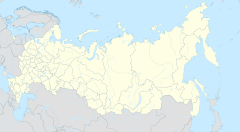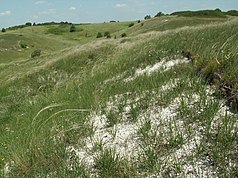Central black earth nature reserve
| Central black earth nature reserve | ||
|---|---|---|
|
|
||
| Location: | Kursk , Russia | |
| Next city: | Kursk | |
| Surface: | 52.9 km² | |
| Founding: | 1935 | |
| Stone figure "Streleckaja Baba" in the part of the Streleckij učastok | ||
| Kazackaja step | ||
| Meadow steppe in the area of the Bukreevy barmy | ||
| Steppe in the subarea Barkalovka | ||
The Central Black Earth Nature Reserve ( Russian Центрально-Чернозёмный Заповедник / Zentralno-Tschernosjomny Sapovednik ) is a nature reserve in the European part of Russia . It was founded in 1935 and is named in honor of the Russian botanist Wassili Wassiljewitsch Alechin , who was the first to discover the botanical peculiarities of the area and who campaigned for its protection. Above all, the reserve serves to protect and research steppes on the fertile black earth (Russian чернозём / Tschernosem ), which have become rare in Russia since the 19th and 20th centuries due to increased agriculture. The protected area has both the status of a sapovednik and a biosphere reserve .
geography
The nature reserve is located in the south-western part of the central Russian plateau. Administratively, it is located on the territories of Kursk Oblast . It consists of six sub-areas: 1) Streleckij učastok (2046 ha), 2) Kazackij učastok (1638 ha), 3) Barkalowka (368 ha), 4) Bukreevy Barmy (259 ha), 5) Zorinskij učastok (495 ha) and 6) Pojma Psla (481.3 ha). The landscape of the protected area consists of rolling hills and plateaus that have been severely carved out by past erosion.
history
In the past two millennia, the area was initially home to various nomadic peoples, such as the Scythians and Cypchaks . A stone figure in Streleckij učastok, the Poloveckaja Baba, testifies to the latter people. Strelizi and Cossacks settled here in the 16th century, who mainly used the surrounding steppes for pasture and mowing. In the 19th and 20th centuries, the steppe in the region was plowed more and more for agriculture. The Russian botanist Alechin, who was born in the Kursk region, first described the steppes of this region as a student and later as a professor at the university. Impressed by the floristic diversity of this region, he campaigned for the area to be placed under protection. The regional museum in Kursk also plays a major role in ensuring that these steppes are not converted into arable land. After 1932 a number of natural history expeditions took place in the area. When the nature reserve was established, the subareas Streleckij učastok, Kazackij učastok and two fragments of Chrenovskaja and Jamskaja Step 'were placed under protection. The Chrenovskaja Step 'was excluded from the reserve after one year and the Jamskaja Step' was transferred to the Belogorje Nature Reserve from 1999 . Barkalowka and Bukreevy Barmy were annexed to the protected area from 1969.
geology
The nature reserve is located on the crystalline Voronežskij shield. In the region both occur chalk , marl and sandy sediments to the surface. The chalk deposits can be seen in the partial areas of the Bukreevy Barmy and Barkalowka, which gave them the name “Belogor'ja” (Russian: White Mountains). In the Streleckij učastok there are also tertiary sands on which ice-age loess deposits are bedded. Karst forms occur in the area.
Floors
Mighty black earths occur in the area, which have formed over loess deposits. The black soils typical of the forest steppe zone cover approx. 50–55% of the area. The rest consists of other black earth types, including podsolized black soils and meadow chernosemes. Since black earth soils are ideally suited for arable farming, they have been plowed up all over the world, including around the protected area. In the Central Black Earth Nature Reserve, however, intact Chernosemes have been preserved, which presumably have never been plowed up.
climate
The nature reserve is located in the temperate cold climate zone. An average of 408 mm of precipitation falls annually, with 70% of the precipitation falling in the months of April to October. The annual average temperature is 5.3 ° C. The winters are cool (January: –9.0 ° C) with frequent frosts, a permanent snow cover and increasing winds (5–6 m / s). The summers are warm (July: 18.7 ° C) and sunny.
Flora and vegetation
The flora includes 855 vascular plant species . The Russian botanist WW Alechin was the first to recognize the special biodiversity of the region. In 1934 he counted 77 species on 1 m² in the Streleckaja Step '. Numerous species that are registered in the Red Book of Russia as protected grow in the area: Orchis militaris , Androsace koso-poljanskii , Paeonia tenuifolia , three types of feather grass ( Stipa pennata , Stipa pulcherrima and Stipa dasyphylla ). Large areas of the protected area are covered by meadow steppe vegetation, for which Stipa tirsa and Stipa capillata are characteristic in addition to the feather grasses mentioned . In the spring, in the steppes of the Adonis flower Adonis vernalis , the pasqueflower Pulsatilla patens , Chess flower ( Fritillaria meleagris and Fritillaria ruthenica ) and narrow-leaved peony ( Paeonia tenuifolia ). The summer aspect is characterized by Salvia nutans , Phlomis tuberosa , Centaurea jacea and Tanacetum vulgare . In some places there are shrub formations with Prunus tenella , Prunus chamaecerasus or Prunus spinosa . Species such as Thymus cretaceus , Linum flavum , Centaurea ruthenica and Schivereckia podolica are found on the chalk outflows , the latter being a rare tertiary relic. Half of the protected area is covered by forests, which are mainly composed of English oaks . These stocks are young forests, because a lot of wood was removed from this area during the time of the civil war and the Second World War.
fauna
The 38 mammals in the area include numerous rodents such as the bank vole , the field vole , the eastern blind vole and the pearly pebble . The red fox is the most common predator in the reserve. Wolves have not been seen in the area in the last century, but in recent years their population has risen to 25-30 individuals and they are hunted by the sanctuary's staff. Ungulates such as wild boar , elk and deer are very numerous in the area. In region 5 are reptiles before: the meadow viper , sand lizard , grass snake , slow worm , and Waldeidechse . Ten species of amphibians are known for the reserve. The most common of them is the green toad . The pond newt , the sea frog and the common toad are far rarer . The list of birds includes 177 species. The most common bird of prey is the common buzzard . In addition, hawks , buzzards , Montagu's harrier and osprey can be found in the area . Gray herons live in the reserve's wetlands . The white stork occurs near the settlement areas.




